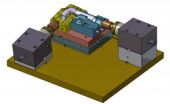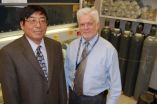(Press-News.org) (NEW YORK, N.Y., October 26, 2012) – The Early Start Denver Model (ESDM), a comprehensive behavioral early intervention program that is appropriate for children with autism spectrum disorder (ASD) as young as 12 months, has been found to be effective in improving social skills and brain responses to social cues in a randomized controlled study published online today in the Journal of the American Academy of Child & Adolescent Psychiatry.
"So much of a toddler's learning involves social interaction, and early intervention that promotes attention to people and social cues may pay dividends in promoting the normal development of the brain and behavior," said Geraldine Dawson, Ph.D., Autism Speaks chief science officer and the study's lead author. This is the first controlled study of an intensive early intervention that demonstrates both improvement of social skills and brain responses to social stimuli resulting from intensive early intervention. Given that the American Academy of Pediatrics recommends that all 18- and 24-month-old children be screened for autism, "it is vital that we have effective therapies available for young children as soon as they are diagnosed," continued Dr. Dawson.
"This may be the first demonstration that a behavioral intervention for autism is associated with changes in brain function as well as positive changes in behavior," said Thomas R. Insel, M.D., director of the National Institute of Mental Health. "By studying changes in the neural response to faces, Dawson and her colleagues have identified a new target and a potential biomarker that can guide treatment development."
ESDM, which combines applied behavioral analysis (ABA) teaching methods with developmental 'relationship-based' approaches, was previously demonstrated to achieve significant gains in cognitive, language and daily living skills compared to children with ASD who received commonly available community interventions. On average, the preschoolers receiving ESDM for two years improved 17.5 standard score points compared to 7.0 points in the community intervention comparison group.
This study sought to address whether the lack of early social engagement associated with ASD could have negative secondary effects on behavioral and brain development. The ESDM approach is novel not only because it is effective in very young children, but it also blends the rigor of applied behavioral analysis (ABA) with play-based routines that focused on building a relationship with the child. During reciprocal social interactions, engagement with a social partner such as a parent, caregiver or therapist is believed to stimulate brain activity associated with the ability to recognize and perceive social information and language. In measuring EEG activity while viewing both social stimuli (faces) and non-social stimuli (toys) this study found that early intervention designed to enhance social attention and social engagement served to alter a child's brain development toward a more positive developmental trajectory. The authors also examined the relationship between EEG activity and behavior outcomes. Previous studies have found that typical babies and young children show more robust brain activity when they view social stimuli, such as faces, than when viewing objects. Children with autism have been found to show the opposite pattern.
"Children receiving ESDM had greater brain activity while viewing faces and also had fewer social-pragmatic problems and improved social communication, such as the ability to initiate interactions, make eye contact, and imitate others," said MIND Institute researcher and co-author Sally Rogers, Ph.D.
Forty-eight children with ASD between 18- and 30-months-old were recruited through pediatric practices, Birth-to-Three centers and state and local autism organizations. These children had a diagnosis of autistic disorder or pervasive developmental disorder not otherwise specified (PDD-NOS). These children were randomly assigned to receive either ESDM or community intervention for a period of two years. The EEG activity was measured at the end of the intervention period. These children were matched by chronological age to typically-developing children at the time of the EEG assessment. The children studied included Asian, white, Latino and multi-racial ethnicities and the male-to-female ratio was 3.5:1. About 60 percent of children in each group provided adequate EEG data for analysis. A group of typical four year olds were also tested for comparison.
Those children receiving ESDM intervention were provided the services of trained therapists for 20 hours a week and parents also were trained to deliver the intervention. Children in the comparison group received treatment as usual in the community and were given evaluations, referrals, and resource manuals and reading materials at the beginning of services and twice annually.
On an individual level, 11 of 15 children with ASD in the ESDM group (73 percent) and 12 of 17 children (71 percent) in the typically-developing or control group showed higher levels of brain activation when viewing faces than when viewing objects compared to only 5 of 14 (36 percent) in the community intervention group of children with ASD. At the end of the study, the children with ASD in the ESDM group exhibited brain activity comparable to age-matched typically-developing children and significantly different from the children with ASD who received community interventions.
"We know that infant brains are quite malleable and had previously demonstrated that this therapy capitalizes on the potential of learning that an infant brain has in order to limit autism's deleterious effects," said Sally Rogers, Ph.D., a professor of psychiatry and behavioral sciences, a study co-author and a researcher at the UC Davis MIND Institute in Sacramento, Calif. "The findings on improved behavioral outcomes and the ability to normalize brain activity associated with social activities has tremendous potential for children with ASD," Rogers explained.
"For the first time, parents and practitioners have evidence that early intervention can result in an improved course of both brain and behavioral development in young children. It is crucial that all children with autism have access to early intervention which can promote the most positive long-term outcomes," concluded Dr. Dawson.
Rogers and Dawson developed the ESDM intervention.
INFORMATION:
Other study authors include Emily J.H. Jones, Ph.D., Kaitlin Venema, Rachel Lowy, Susan Faja, Ph.D., Dana Kamara, Michale Murias, Ph.D., Jessica Greenson, Ph.D., Jamie Winter, Ph.D., Milani Smith, Ph.D., and Sara J. Webb Ph.D., all of the Center on Human Development and Disability (CHDD) at University of Washington; and Kristen Merkle of Vanderbilt University.
The study was funded by a grant from the National Institute of Mental Health (NIMH) and by a postdoctoral fellowship from Autism Speaks.
About Autism
Autism is a general term used to describe a group of complex developmental brain disorders – autism spectrum disorders – caused by a combination of genes and environmental influences. These disorders are characterized, in varying degrees, by communication difficulties, social and behavioral challenges, as well as repetitive behaviors. An estimated 1 in 88 children in the U.S. is on the autism spectrum – a 78 percent increase in six years that is only partly explained by improved diagnosis.
About Autism Speaks
Autism Speaks is the world's leading autism science and advocacy organization. It is dedicated to funding research into the causes, prevention, treatments and a cure for autism; increasing awareness of autism spectrum disorders; and advocating for the needs of individuals with autism and their families. Autism Speaks was founded in February 2005 by Suzanne and Bob Wright, the grandparents of a child with autism. Mr. Wright is the former vice chairman of General Electric and chief executive officer of NBC and NBC Universal. Since its inception, Autism Speaks has committed over $180 million to research and developing innovative resources for families. Each year Walk Now for Autism Speaks events are held in more than 95 cities across North America. On the global front, Autism Speaks has established partnerships and related activities in over 40 countries on 5 continents to foster international research, services and awareness. To learn more about Autism Speaks, please visit AutismSpeaks.org.
About UC Davis MIND Institute
At the UC Davis MIND Institute, world-renowned scientists engage in collaborative, interdisciplinary research to find the causes of and develop treatments and cures for autism, attention-deficit/hyperactivity disorder (ADHD), fragile X syndrome, 22q11.2 deletion syndrome, Down syndrome and other neurodevelopmental disorders. More information about the institute is available on the web at http://www.mindinstitute.org.
ESDM early intervention improves brain activity associated with social cues
Achieves significant gains in social interaction and brain activity associated with response to social cues
2012-10-26
ELSE PRESS RELEASES FROM THIS DATE:
Autism early intervention found to normalize brain activity in children as young as 18 months
2012-10-26
An intensive early intervention therapy that is effective for improving cognition and language skills among very young children with autism also normalizes their brain activity, decreases their autism symptoms and improves their social skills, a nationwide study has found. The researchers said the study is the first to demonstrate that an autism early intervention program can normalize brain activity.
"We know that infant brains are quite malleable and previously demonstrated that this therapy capitalizes on the potential of learning that an infant brain has in order ...
Feinstein Institute researchers discover that bean used in Chinese food could protect against sepsis
2012-10-26
MANHASSET, NY – Researchers at The Feinstein Institute for Medical Research have discovered that a bean commonly used in Chinese cuisine protects against the life-threatening condition sepsis. These findings are published in the current issue of Evidence-based Complementary and Alternative Medicine (eCAM).
It has been found that a deoxyribonucleic acid (DNA) protein, HMGB1, mediates inflammation. Inflammation is necessary for maintaining good health – without inflammation, wounds and infections would never heal. However, persistent and constant inflammation can damage ...
Results of the XIMA trial presented at TCT 2012
2012-10-26
MIAMI, FL – OCTOBER 26, 2012 – Rarely tested in patients over the age of 80, a study found that drug-eluting stents exhibited some benefits over bare-metal stents, though both types of stents demonstrated a clinical benefit. Results of the XIMA trial were presented today at the 24th annual Transcatheter Cardiovascular Therapeutics (TCT) scientific symposium. Sponsored by the Cardiovascular Research Foundation (CRF), TCT is the world's premier educational meeting specializing in interventional cardiovascular medicine.
Patients over the age of 80 are often excluded from ...
Cost-effective titanium forming
2012-10-26
To all intents and purposes, nothing stands in the way of titanium in terms of becoming a first-choice industrial material. It is a practically unlimited resource; it is stable and lightweight, but also extremely malleable as well as corrosion and temperature resistant. Nevertheless, this white silver lustrous metal remains in the shadows of steel, chrome, nickel and aluminum when it comes to manufacturing. The reason for this is that efficient metal forming processes such as deep drawing or hydroforming can only be used in a very limited way. "Titanium tends to adhere ...
A Viagra follow-up? Drug used to treat glaucoma actually grows human hair
2012-10-26
If you're balding and want your hair to grow back, then here is some good news. A new research report appearing online in The FASEB Journal (www.fasebj.org) shows how the FDA-approved glaucoma drug, bimatoprost, causes human hair to regrow. It's been commercially available as a way to lengthen eyelashes, but these data are the first to show that it can actually grow human hair from the scalp.
"We hope this study will lead to the development of a new therapy for balding which should improve the quality of life for many people with hair loss," said Valerie Randall, a researcher ...
Anesthesia type affects outcomes of bilateral knee replacement surgery
2012-10-26
Using regional anesthesia rather than general anesthesia reduces the need for blood transfusions in patients undergoing bilateral total knee replacement, according to a new study by researchers at Hospital for Special Surgery, in New York City.
Currently, the majority of bilateral knee replacements in the United States (as well as single knee replacements) are performed under general anesthesia, and researchers say that a regional anesthesia known as neuraxial anesthesia should be promoted for these procedures.
"The use of neuraxial anesthesia may not always be feasible ...
Glass: Characterizing with precision and efficiency
2012-10-26
At home, in the car or with industrial processes – glass is a universal material. Its properties are so extraordinary that frequently there are no alternatives to this material. Take, for example, high-temperature fuel cells, in which layers of ceramics and metals are alternately attached to each other: to ensure no explosive hydrogen escapes, the metal and ceramic layers must be firmly bound to each other, and the seam must be sealed tight. Only glass can accomplish this type of seal – and here, we are specifically referring to solder glass. But how does glass behave at ...
Scientists step up hunt for bacterial genes tied to Lyme disease
2012-10-26
Investigators at The University of Texas Health Science Center at Houston (UTHealth) have accelerated the search for the bacterial genes that make the Lyme disease bacterium so invasive and persistent. The discovery could advance the diagnosis and treatment of this disease, which affects an estimated 30,000 Americans each year.
The researchers have developed a new technique that allowed them to test 15 times more bacterial genes than had been evaluated in the previous 30 years to ascertain their roles in infection. Findings appeared Oct. 25 in the journal The Public Library ...
Hermit crabs socialize to evict their neighbors
2012-10-26
Social animals usually congregate for protection or mating or to capture bigger prey, but a University of California, Berkeley, biologist has found that the terrestrial hermit crab has a more self-serving social agenda: to kick another crab out of its shell and move into a larger home.
All hermit crabs appropriate abandoned snail shells for their homes, but the dozen or so species of land-based hermit crabs – popular terrarium pets – are the only ones that hollow out and remodel their shells, sometimes doubling the internal volume. This provides more room to grow, more ...
NASA sees Tropical Storm Son-tinh moving through South China Sea
2012-10-26
NASA's Terra satellite got a good look at Tropical Storm Son-tinh moving through the South China Sea and headed for landfall in Vietnam.
NASA's Terra satellite flew over Son-Tinh on Oct. 26 at 0305 UTC (Oct. 25 at 11:05 p.m. EDT) and the Moderate Resolution Imaging Spectroradiometer (MODIS) instrument aboard captured a visible image of the storm. At the time, Son-tinh's western edge had already moved away from the Philippines. The image revealed powerful thunderstorms in the northwestern quadrant of the storm, and in the storm's center.
On Oct. 26 at 1500 UTC, Tropical ...
LAST 30 PRESS RELEASES:
Structure of dopamine-releasing neurons relates to the type of circuits they form for smell-processing
Reducing social isolation protects the brain in later life
Keeping the heart healthy increases longevity even after cancer
Young adults commonly mix cannabis with nicotine and tobacco
Comprehensive review illuminates tau protein's dual nature in brain health, disease, and emerging psychiatric connections
Book prepares K-12 leaders for the next public health crisis
Storms in the Southern Ocean mitigates global warming
Seals on the move: Research reveals key data for offshore development and international ecology
Sports injuries sustained during your period might be more severe
World's first successful 2 Tbit/s free-space optical communication using small optical terminals mountable on satellites and HAPS
Can intimate relationships affect your heart? New study says ‘yes’
Scalable and healable gradient textiles for multi‑scenario radiative cooling via bicomponent blow spinning
Research shows informed traders never let a good climate crisis go to waste
Intelligent XGBoost framework enhances asphalt pavement skid resistance assessment
Dual-function biomaterials for postoperative osteosarcoma: Tumor suppression and bone regeneration
New framework reveals where transport emissions concentrate in Singapore
NTP-enhanced lattice oxygen activation in Ce-Co catalysts for low-temperature soot combustion
Synergistic interface engineering in Cu-Zn-Ce catalysts for efficient CO2 hydrogenation to methanol
COVID-19 leaves a lasting mark on the human brain
Scientists use ultrasound to soften and treat cancer tumors without damaging healthy tissue
Community swimming program for Black youth boosts skills, sense of belonging, study finds
Specific depressive symptoms in midlife linked to increased dementia risk
An ‘illuminating’ design sheds light on cholesterol
Who is more likely to get long COVID?
Study showcases resilience and rapid growth of “living rocks”
Naval Research Lab diver earns Office of Naval Research 2025 Sailor of the Year
New Mayo-led study establishes practical definition for rapidly progressive dementia
Fossil fuel industry’s “climate false solutions” reinforce its power and aggravate environmental injustice
Researchers reveal bias in a widely used measure of algorithm performance
Alcohol causes cancer. A study from IOCB Prague confirms damage to DNA and shows how cells defend against it
[Press-News.org] ESDM early intervention improves brain activity associated with social cuesAchieves significant gains in social interaction and brain activity associated with response to social cues





